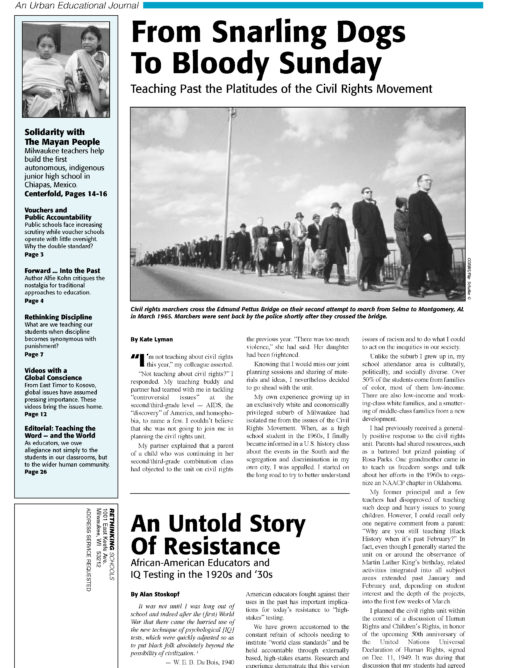Preview of Article:
Videos with a Global Conscience
From East Timor to sweatshops, global issues have assumed pressing importance. These videos can bring the issues home to U.S. classrooms
* Banking on Life and Debt. 1995. Robert Richter, producer. (30 min.) “It’s easier to get a camel through the eye of a needle than for a banker to feel sorry for a child who is starving, dying of starvation,” claims the Brazilian radical politician, “Lula,” in Banking on Life and Debt. The video is an overview of World Bank and International Monetary Fund policies that promote poverty, starvation, and ecological ruin. Measured by its ability to engage most high school students, Banking on Life and Debt is spread too thin, covers too much history and too much political economy, and is narrated by too many talking heads. Nonetheless, through examining World Bank and IMF policies in Ghana, Brazil, and the Philippines, the video offers a convincing portrait of an international economic order that drains resources from poor countries in the name of development. And if used with other readings and activities that explore the global debt crisis, this can be an important resource.
The snapshot of Brazil helps clarify the relationship between debt crisis and environmental crisis. Brazil has been ordered to turn more of its land to production for export. Increasing amounts of land are planted in soybeans. As Brazil’s Cardinal Arns points out, “The food that we were supposed to eat [is] being sent to cows and pigs in other countries.” Other poor countries receive the same IMF prescription, and flooded commodity markets pull down prices of Third World raw materials. Meanwhile, Brazilian poor farmers lose their land to huge corporations and become squatters, every year hacking down more and more Amazonian rainforest.
The video doesn’t bubble-over with hope, but we do meet activists in every country visited who describe efforts to organize for alternatives to debt slavery. (Maryknoll)
The Debt Crisis: An Un-Natural Disaster. 1990. Social Action Centre, Jamaica. (Includes a short teaching guide.) (28 min.) Using delightful skits, songs, and expert testimony, this video is a primer on the history and social consequences of the Third World debt crisis and structural adjustment programs, especially focusing on the Caribbean. It has something of a home-made feel to it and lacks the polish that students are used to, but it is a clear and hard-hitting overview of the severe difficulties the debt crisis creates in poor countries. One of the video’s strengths is that it is entirely narrated, and the skits acted, by Caribbean people themselves. The Debt Crisis covers much the same ground as Banking on Life and Debt, although its Caribbean focus is narrower. However, the playfulness (some might argue, silliness) of its skits and its concentration on a smaller geographic area probably make this more accessible for many students. (Friendship Press)
*Where Are the Beans? 1994. Mennonite Central Committee, producer. (13 min.) Where Are the Beans? is a kind of detective story – and an excellent classroom resource. Linda Shelly, of the Mennonite Central Committee, lived in La Esperanza, Honduras for several years. While there, she loved to eat red beans, a staple of the Honduran diet. But when she returned in 1993, she found that no one ate beans any longer. Where are the beans? is the question that Shelly pursues as she visits old friends to learn about how their lives have changed.</p

